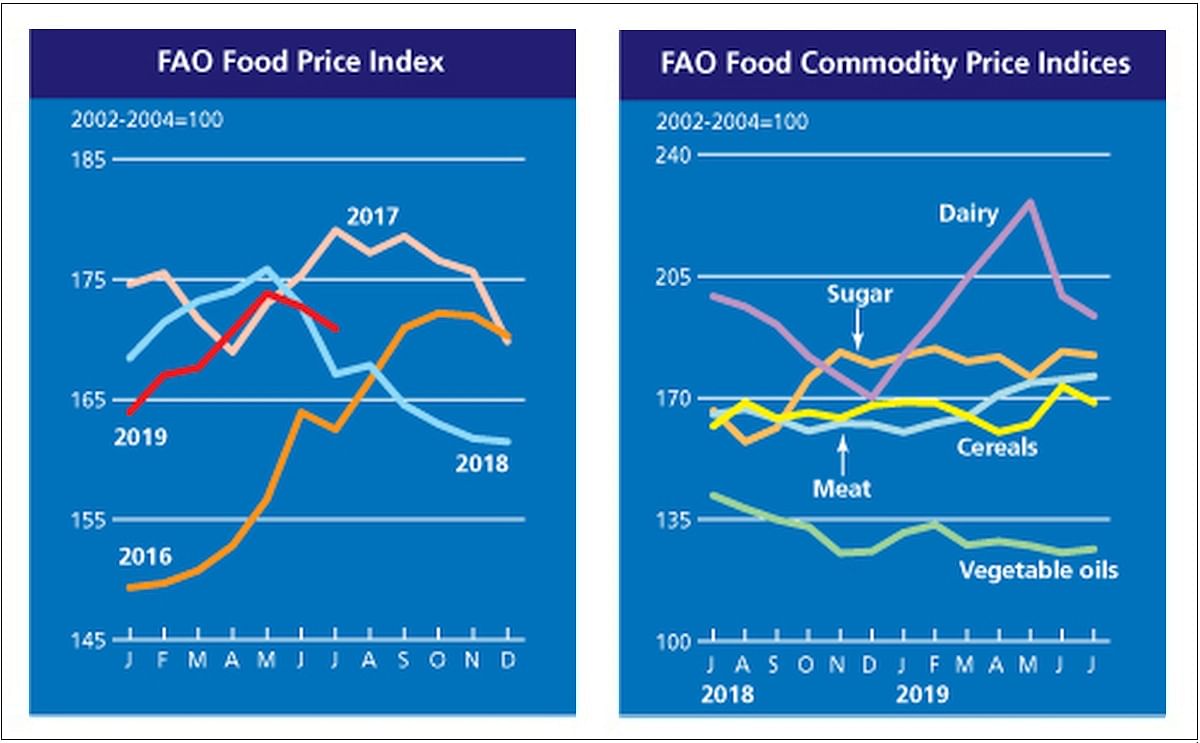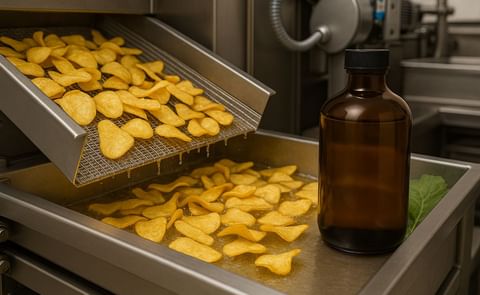The FAO Food Price Index averaged 170.9 points in July 2019, down 1.1 percent (1.8 points) from June but 2.3 percent higher than in July 2018.
FAO Food Price Index down slightly in July

The FAO Food Price Index (FFPI) averaged 170.9 points in July 2019, down 1.1 percent (1.8 points) from June but 2.3 percent higher than in July 2018. The month-on-month decline was the result of lower prices for some cereals, dairy products and sugar, which more than offset somewhat firmer prices for meat and oils.
The FAO Cereal Price Index averaged 168.6 points in July, down 2.7 percent (4.6 points) from June but 4.1 percent above its level in the corresponding month last year.
The decline in July was driven by lower wheat and maize prices. In wheat markets, despite downward adjustments to production prospects in several countries, large export supplies and continued expectations of record world production this year weighed on international prices.
Similarly, after their rapid surge in June, international maize prices fell in July; ample export availabilities, particularly in Argentina and Brazil, contributed to the slide. However, FAO's all rice price index marked its fifth successive month of stability, amid generally quiet market activity.
The FAO Vegetable Oil Price Index averaged 126.5 points in July, up 0.8 percent (one point) from the previous month but still 11 percent below last year’s corresponding level.
Overall, firmer soy and sunflower oil prices more than offset a further drop in palm oil values. The concurrence of seasonal production rises in Southeast Asia and sluggish global import demand continued weighing on palm oil prices.
On the other hand, soyoil prices appreciated almost in tandem with rising soybean values while low crush volumes in the United States also contributed to the increase. Similarly, sunflower oil firmed as a slowdown in crushing in the Black Sea region coincided with robust international demand.
The FAO Meat Price Index averaged 176.2 points in July, up 0.6 percent (one point) from its slightly revised value for June and registering the sixth moderate month-on-month price increase.
At this level, the index value stands at nearly 10 percent above that of January 2019, but almost 17 percent below its peak in August 2014. In July, price quotations for ovine meat rose further, boosted by strong import demand from Asia amid supplies from Oceania retreating from their seasonal highs.
Asia’s robust import demand for bovine meat also contributed to further gains in bovine prices. However, quotations for pigmeat were down slightly after four months of continued increases, reflecting larger export availabilities from Brazil and the United States. Poultry quotations held firm at June levels, with markets characterized by generally stable but still strong demand.
The FAO Dairy Price Index averaged 193.5 points in July, down 2.9 percent (5.7 points) from June, representing the second consecutive month of decline.
At this level, the index value is some 6 percent above that of January 2019 but almost 3 percent below the corresponding month last year. In July, quotations for butter declined the most, followed by cheese and Whole Milk Powder (WMP). Weakness from lacklustre spot market trading, as the summer holiday period in the Northern hemisphere enters its peak, contributed to the weaker prices. By contrast, Skim Milk Powder (SMP) prices recovered, supported by firmer buying interest from the Middle East and Asia.
The FAO Sugar Price Index averaged 182.2 points in July, down 0.6 percent (one point) from June 2019, mainly on expectations for higher sugarcane yields in India, the world’s largest sugar producer, following above average rainfalls in the main sugar producing regions.
The decline in world prices was, however, somewhat contained by a strengthening of the Brazilian currency (Real) against the United States Dollar, a move that tends to restrain exports from Brazil, the world’s largest sugar exporter. In addition, new estimates pointing to smaller sugar production in Brazil’s Centre-South through June also provided some support.
The FAO Cereal Price Index averaged 168.6 points in July, down 2.7 percent (4.6 points) from June but 4.1 percent above its level in the corresponding month last year.
The decline in July was driven by lower wheat and maize prices. In wheat markets, despite downward adjustments to production prospects in several countries, large export supplies and continued expectations of record world production this year weighed on international prices.
Similarly, after their rapid surge in June, international maize prices fell in July; ample export availabilities, particularly in Argentina and Brazil, contributed to the slide. However, FAO's all rice price index marked its fifth successive month of stability, amid generally quiet market activity.
The FAO Vegetable Oil Price Index averaged 126.5 points in July, up 0.8 percent (one point) from the previous month but still 11 percent below last year’s corresponding level.
Overall, firmer soy and sunflower oil prices more than offset a further drop in palm oil values. The concurrence of seasonal production rises in Southeast Asia and sluggish global import demand continued weighing on palm oil prices.
On the other hand, soyoil prices appreciated almost in tandem with rising soybean values while low crush volumes in the United States also contributed to the increase. Similarly, sunflower oil firmed as a slowdown in crushing in the Black Sea region coincided with robust international demand.
The FAO Meat Price Index averaged 176.2 points in July, up 0.6 percent (one point) from its slightly revised value for June and registering the sixth moderate month-on-month price increase.
At this level, the index value stands at nearly 10 percent above that of January 2019, but almost 17 percent below its peak in August 2014. In July, price quotations for ovine meat rose further, boosted by strong import demand from Asia amid supplies from Oceania retreating from their seasonal highs.
Asia’s robust import demand for bovine meat also contributed to further gains in bovine prices. However, quotations for pigmeat were down slightly after four months of continued increases, reflecting larger export availabilities from Brazil and the United States. Poultry quotations held firm at June levels, with markets characterized by generally stable but still strong demand.
The FAO Dairy Price Index averaged 193.5 points in July, down 2.9 percent (5.7 points) from June, representing the second consecutive month of decline.
At this level, the index value is some 6 percent above that of January 2019 but almost 3 percent below the corresponding month last year. In July, quotations for butter declined the most, followed by cheese and Whole Milk Powder (WMP). Weakness from lacklustre spot market trading, as the summer holiday period in the Northern hemisphere enters its peak, contributed to the weaker prices. By contrast, Skim Milk Powder (SMP) prices recovered, supported by firmer buying interest from the Middle East and Asia.
The FAO Sugar Price Index averaged 182.2 points in July, down 0.6 percent (one point) from June 2019, mainly on expectations for higher sugarcane yields in India, the world’s largest sugar producer, following above average rainfalls in the main sugar producing regions.
The decline in world prices was, however, somewhat contained by a strengthening of the Brazilian currency (Real) against the United States Dollar, a move that tends to restrain exports from Brazil, the world’s largest sugar exporter. In addition, new estimates pointing to smaller sugar production in Brazil’s Centre-South through June also provided some support.
Like to receive news like this by email? Join and Subscribe!
Get the latest potato industry news straight to your WhatsApp. Join the PotatoPro WhatsApp Community!
Highlighted Company
Sponsored Content
Sponsored Content
Sponsored Content
Sponsored Content









